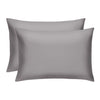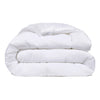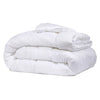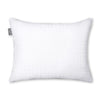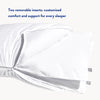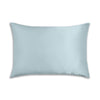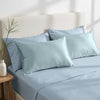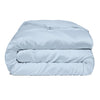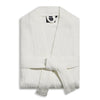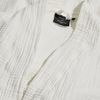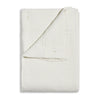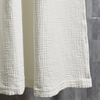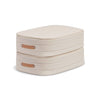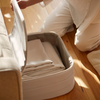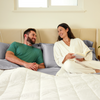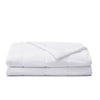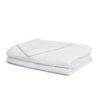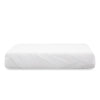
If you’ve ever climbed into bed only to feel those annoying fuzz balls ruining the smooth texture of your sheets, you know just how irritating pilling can be. It not only makes your bedding feel rough and worn but can also shorten its lifespan if left unchecked. Figuring out how to minimize pilling without damaging the fabric is a common challenge, especially when you want your sheets to stay soft and luxurious for years. Whether you’re tired of dealing with fuzz, curious about how to get rid of pilling on sheets, or simply want to prevent pilling from happening in the first place, this guide covers everything you need to know to keep your bedding in top condition.
What Is Pilling on Sheets?
Pilling refers to the tiny fuzz balls or clumps of tangled fibers that form on the surface of your sheets. These small pills develop when loose fibers rub against one another and twist into little knots. It’s a normal occurrence, especially in fabrics like cotton, flannel, or synthetic blends, but it can make sheets feel less comfortable and look worn out. While pilling doesn’t necessarily mean your sheets are poor quality, excessive fuzz is a sign that the fibers are breaking down faster than expected. Understanding what causes pilling is the first step toward preventing it and keeping your bedding soft and smooth.
What Causes Pilling on Bed Sheets?
Pilling is usually the result of friction, washing, and general wear. The following are the most common causes:
-
Friction and abrasion: Movement during sleep, washing, or drying can loosen fibers and create tangles.
-
Fiber quality: Sheets made from shorter or lower-quality fibers tend to pill faster.
-
Weaving technique: Loosely woven fabrics are more prone to friction damage.
-
Washing and drying: Harsh detergents, aggressive spin cycles, or high heat can weaken fibers.
-
Fabric composition: Synthetic blends like polyester or microfiber are more likely to pill than long-staple natural fibers.
If you want to avoid these issues entirely, start with durable, long-staple cotton bed linens like the Miracle Made Sheet Set, designed to resist pilling and stay smooth over time thanks to high-quality fibers and advanced weave technology.
What Tools Are Best for Removing Pilling from Sheets?
Removing pilling is easier when you have the right tools. A fabric shaver is one of the most effective options since it gently removes fuzz without damaging the material. For lighter cases, a lint roller works well to lift surface pills, though it may require more effort. If you prefer something simple, a pumice stone, clean razor, or even a pair of scissors can also do the job—just use gentle, even strokes to avoid cutting the fabric. Always start with light pressure and work in small sections to keep your sheets safe.
Can You Remove Pilling Without a Fabric Shaver?
Yes, you can remove pilling without a specialized device, and sometimes a simple pair of scissors can trim off larger pills. A lint roller can pick up loose fuzz, and a fine-grit pumice stone can help with more stubborn areas. If you’re careful, a disposable razor can also be used by gliding it slowly across the surface to lift pills away. Be patient and work in one direction to prevent fiber snags. While these methods take more time, they’re just as effective and can refresh your bedding’s appearance between deeper cleanings.
How Do Different Fabric Types React to Pilling Removal?
Different fabrics require different levels of care when removing pills. Delicate materials like silk or satin should only be treated with a lint roller or a low-setting fabric shaver to prevent fiber damage. Cotton sheets, especially those made from long-staple fibers like Egyptian or Pima cotton, can safely handle gentle fabric shavers or pumice stones. Flannel and polyester blends tend to pill more frequently but are durable enough for light abrasion. Always test your removal method on a small, hidden section first to ensure it doesn’t harm the fabric.
How Can Washing Techniques Help Prevent Pilling on Sheets?
How you wash your sheets has a big impact on their resistance to pilling. Always turn sheets inside out before washing to protect the outer surface. Use cold or lukewarm water and select a gentle cycle to minimize friction. Avoid overloading your washer since overcrowding increases rubbing between fabrics. When drying, choose a low-heat setting or air-dry when possible to preserve the fibers.
A mild detergent is also key. Harsh formulas can strip away natural fibers and encourage pilling. The Miracle Made Laundry Detergent Sheets offer a great alternative to liquid or powder detergents, providing a residue-free clean that keeps fibers smooth and strong.
Is There a Way to Restore Sheets After Removing Pills?
Once you’ve removed pills, restoring softness is simple. Wash your sheets with a gentle detergent and add a small amount of white vinegar during the rinse cycle to help smooth fibers naturally. A short tumble on low heat can fluff the fabric and restore its original feel. For an extra boost, use a gentle fabric refresher spray or a few dryer balls to maintain softness without chemical buildup. These steps not only make your sheets feel new again but also help prevent new pills from forming.
How Often Should You Remove Pilling to Keep Sheets Looking New?
Most people should learn how to get rid of pilling on sheets every one to three months, depending on how often they use their sheets. If you notice fuzz forming more frequently, it may be worth switching to higher-quality bedding materials or adjusting your washing habits. Consistent maintenance makes the process easier and prevents buildup over time. Regular care paired with proper washing and drying ensures your bedding stays smooth and inviting.
What Fabrics Are Least Prone to Pilling?
Some fabrics are naturally more resistant to pilling. When choosing new bedding, consider the following options:
-
Long-staple fibers: Egyptian cotton and Pima cotton resist pilling because their longer fibers are stronger and less likely to break.
-
Tightly woven materials: Percale and sateen weaves offer smoother surfaces that reduce friction and wear.
-
Smooth natural fibers: Silk and Tencel Lyocell have strong, sleek fibers that resist tangling and fuzz formation.
-
High-quality blends: Premium synthetic fabrics with longer fibers pill less than low-cost alternatives.
Common Mistakes and Expert Tips for Preventing Sheet Pilling
Skipping proper washing technique: Always turn sheets inside out before washing to minimize friction and surface wear.
Using harsh detergents: Strong chemical cleaners weaken fibers over time. Opt for mild detergents like the Miracle Made Laundry Detergent Sheets for gentle yet effective cleaning.
Skipping fabric conditioner: A small amount of fabric softener or vinegar in the rinse cycle helps reduce static and friction between fibers.
Overloading the washer: Crowding the washing machine increases rubbing and abrasion. Wash smaller loads to give your sheets room to move freely.
Ignoring loose threads: Snags or pulled threads can turn into more serious pilling. Smooth or trim any loose ends as soon as you notice them.
Choosing low-quality fibers: Sheets made from short or synthetic fibers will pill faster. Investing in long-staple, high-quality fabrics ensures better durability and comfort.
Conclusion
Pilling on sheets might be frustrating, but it’s not permanent—and with the right care, it's easy to learn how to get rid of pilling on sheets. Regular washing with mild detergent, gentle drying, and the occasional touch-up with a fabric shaver can keep your bedding looking new. Most importantly, choosing high-quality, long-staple cotton sheets like the Miracle Made Sheet Set will naturally minimize pilling thanks to stronger fibers and smoother weaves. Combine thoughtful maintenance with these expert techniques, and you’ll enjoy luxuriously soft, pill-free sheets that last for years of comfortable, restful sleep.


